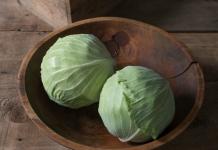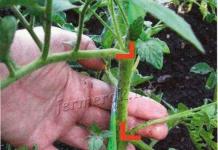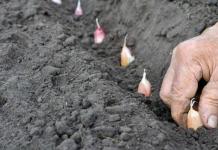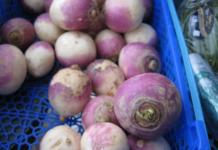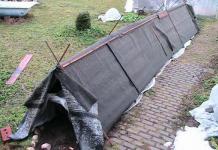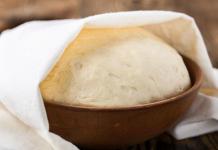Storing cabbage in a cellar is a delicate matter. Our main goal is to keep heavy, dense forks juicy and fresh for as long as possible. It can be solved with timely cleaning, creating suitable conditions in the basement, and using a number of small tricks. But let's talk about everything in order.
When and how to harvest cabbage for storage
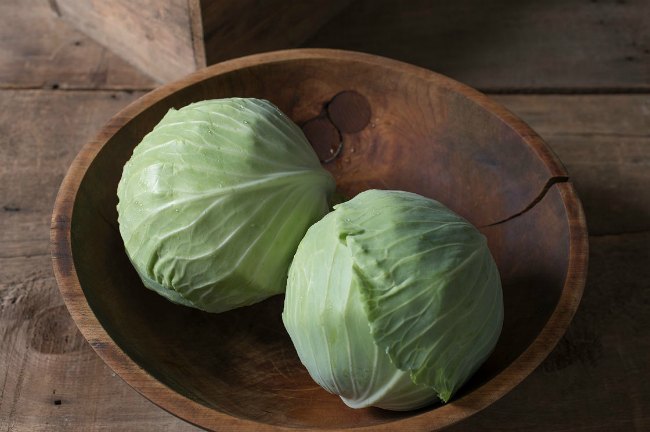 Depending on the variety, white cabbage ripens at different times. Late and mid-late varieties are suitable for winter storage, which are harvested as they reach the required degree of maturity.
Depending on the variety, white cabbage ripens at different times. Late and mid-late varieties are suitable for winter storage, which are harvested as they reach the required degree of maturity.
Heads of cabbage ready for cutting of late-ripening white cabbage should weigh at least 0.8 kilograms, and early maturing - at least 0.3 kilograms.
In mid-latitudes, white cabbage is usually harvested in the last decade of October, before the first autumn frosts. Dry sunny weather with an air temperature of +3 ... 8 degrees is best suited for this work. When harvesting in the rain, the heads of cabbage need to be dried under a canopy, and only then transported to the storage.
Choosing the timing of harvesting plays a critical role in the successful storage of cabbage in the cellar. After all, if you rush to cut the heads of cabbage, then due to the too warm air in the storage they will not be able to cool down properly, which will provoke the rapid spread of diseases.
On the other hand, if the crop falls under the first serious autumn frosts, the vegetables will freeze and lose keeping quality. However, short-term frosts not lower than -4 ... 5 degrees will not harm the late white pot of mature varieties. Only then, before harvesting it, it is necessary to let the heads of cabbage thaw in the bud and use them for food very first.
Ripe forks are cut with a sharp secateurs, chopped down with a hatchet, or pulled out of the soil along with the rhizomes. In this case, you need to leave a stump with an even cut, two to three centimeters long.
When harvesting, a few covering leaves are also left on the forks. The upper leaves will protect the heads of cabbage from mechanical damage during transportation and storage, as well as protect them from disease damage in the vegetable store.
After that, the harvested crop is subjected to sorting, during which heavily damaged, overripe (cracked) and diseased specimens are rejected. The remaining forks are placed on trolleys and transported to a storage location.
Keep in mind that the keeping quality of white cabbage is largely determined by varietal characteristics. Therefore, it is better to store different varieties of this culture separately from each other (less mature - closer to the entrance to the basement, more mature - at its far end). Besides, It is advisable to sort cabbage by size, since large and small heads of cabbage are worse than average.
Methods for storing cabbage in the cellar and basement
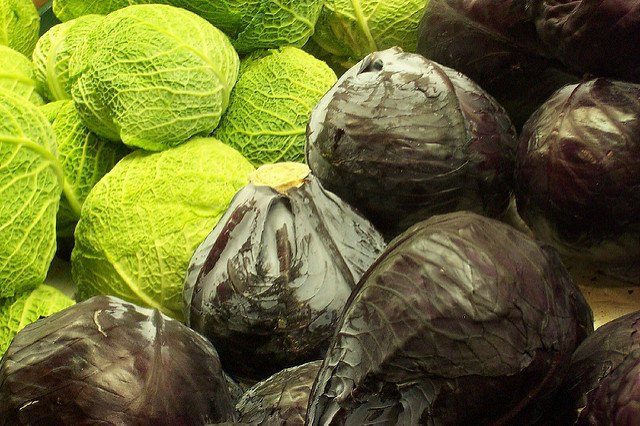
Cabbage heads must be dried before storing them in the cellar!
The most popular way to store cabbage in a cellar or basement is on shelves. In this case, it is desirable that the racks are collapsible for regular washing and disinfection.
The forks are placed on the shelves in rows in two to three layers. There should be at least 30 centimeters of air space between the top row of vegetables and the overhanging rack. This will ensure good air circulation.
If there is not much cabbage, then it can be picked up by stumps to the racks of the shelves or to the ceiling of the storage.
In the basement, cabbage is usually stored in pyramid-shaped stacks. Its height should be 50-100 centimeters, and the width of the base should be 100-200 centimeters. The inner forks are laid with stumps upward, and the outer forks are laid down. This option allows you to place the crop very compactly - in this case, one square meter of storage will fit up to 200 kilograms of cabbage.
If you do not have the opportunity to equip the cellar with shelving, then you can organize the storage of cabbage in trellis made of wood. To do this, the forks are placed in boxes in two layers in the same way as in the previous method - the lower stumps up, the upper ones down. The boxes are kept on shelves located at a distance of at least 20 centimeters from the cellar floor. To improve keeping quality, each individual head of cabbage can be wrapped in thick paper. If the paper becomes wet and dark over time, it must be replaced.
A certain number of heads of cabbage can be "planted" in stumps in the sand poured on the floor of the vegetable store. They are placed at a distance of 5-8 centimeters from one another, kept at a temperature of at least +8 ... 10 degrees and consumed first.
And one more thing: immediately after laying the cabbage for storage, the forks need to be cooled and slightly dried. To this end, for two to three days, the ventilation holes and doors are kept open during the daytime (they are closed during night frosts).
To reduce spoilage of cabbage during storage, you can sprinkle each row of cabbage with a thin layer of crushed chalk or slaked lime. For 100 kilograms of heads of cabbage, you need 2-3 kilograms of these substances.
Storage conditions for cabbage
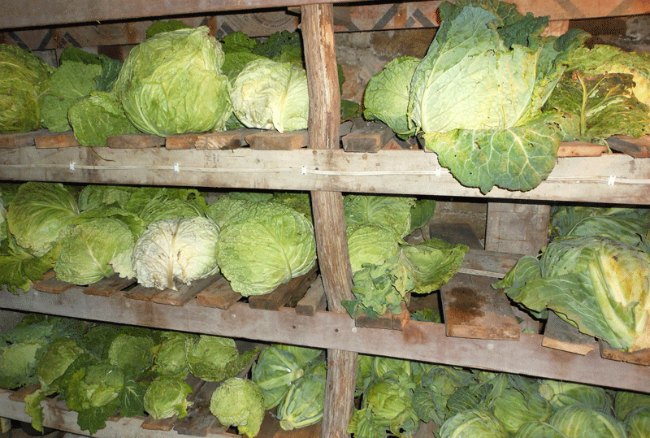 Regardless of the chosen storage method for cabbage, it is necessary to ensure the required storage conditions for the crop. The most significant of them are temperature and humidity.
Regardless of the chosen storage method for cabbage, it is necessary to ensure the required storage conditions for the crop. The most significant of them are temperature and humidity.
The preferable temperature for storing a white calf is from 0 to -1 degrees. The thing is that the insides of the heads of cabbage are less resistant to subzero temperatures than the outer leaves. So, it freezes and dies already at -1.5 degrees, while the outer parts are able to withstand a cold snap down to -7 degrees.
After thawing, frozen vegetables quickly turn black and begin to rot, while emitting a nasty vinegar smell. However, if the temperature in the cellar does not drop below -1 degrees, you will not face such a nuisance.
If it is too warm in the vegetable store, the heads of cabbage placed there will also begin to deteriorate very quickly. It is known that during storage, the temperature inside the stack increases by an average of one degree every 24 hours. Generally speaking, cabbage generates much more heat during storage than many other vegetables.
To combat the constant rise in temperature in the cellar or basement, the store must be equipped with a high-quality ventilation system.
At a humidity level close to 100%, heads of cabbage quickly rot. But if this indicator falls below 90%, then the cabbage, on the contrary, begins to dry out and lose weight. Therefore, it is desirable that the moisture content in the storage has always remained in the range of 90 to 95%.
To control the temperature in several places of the vegetable store, you need to hang thermometers, and to regulate it, limit or increase the supply of cold air into the room through hoods or hatches. In winter, cabbage is periodically examined, removing diseased specimens and removing rotten leaves from the heads of cabbage.
Keep in mind that untimely harvesting, poor sorting and storage conditions lead to the emergence of various types that affect the cabbage during its stay in the vegetable store.
Haven't got a cellar or basement yet? No problem! Cabbage heads can even be frozen (of course, if the winters in your area are cold enough and without frequent thaws). To do this, the crop is harvested from the garden just before the frosts in and stored in the country in any dry place (for example, under a canopy).





